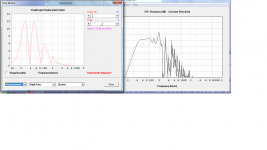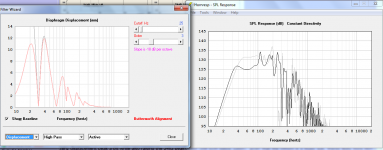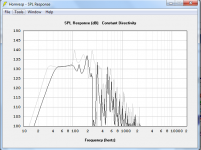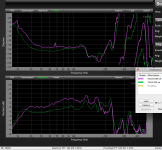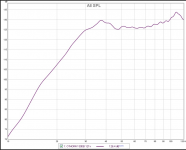pic one is a tbw100 loaded keystone at 82 volts, 29hz 4th order hipass (xmax limit) vs the othorn tbw100 at 62 volts, 25hz 3rd order hipass. As far as this driver is concerned, I think its more suited for the keystone (although the othorn does still go marginaly lower).
Pic 3 is the othorn 21sw152 4 with 95 volts (theoretically 15mm xmax limit with 24hz 3rd order hipass) grey line, vs the tbw100 keystone with 82 volts and the hipass listed above. With the recomended driver and the amp power behind it, the othorn really flexes its weight imo, making it REALLY nice box for its size.
Oh if only I had the 900 dollars I needed . looks like it'll be keystones for me for a while until I can afford what it takes to get to 30hz proper (both in amps and in speakers lol)
. looks like it'll be keystones for me for a while until I can afford what it takes to get to 30hz proper (both in amps and in speakers lol)
Great design ricci, loving your website right now, thank you for posting such well documented specs on all the drivers and enclosures you've tested. hope to build one of these in the not toooooo far future.
Pic 3 is the othorn 21sw152 4 with 95 volts (theoretically 15mm xmax limit with 24hz 3rd order hipass) grey line, vs the tbw100 keystone with 82 volts and the hipass listed above. With the recomended driver and the amp power behind it, the othorn really flexes its weight imo, making it REALLY nice box for its size.
Oh if only I had the 900 dollars I needed
Great design ricci, loving your website right now, thank you for posting such well documented specs on all the drivers and enclosures you've tested. hope to build one of these in the not toooooo far future.
Attachments
The "normal" Keystone with a BC 18SW115-4 has -3dB points at 34 and 230 Hz, though response is pretty ragged above 125 Hz, which is what I'd put the upper usable frequency at. The 18TBW100 sims pretty much the same, but I have not actually tried one yet.So what would be -3db LF and upper usable frequency for the 18TBW100 in the Keystone with an optimally sized mouth?
With lots of PEQ filters, 180- 200 Hz would be doable, above 230 Hz the phase goes wonky.
By reducing the Keystone mouth area to 200 square inches, the -3dB LF can be lowered to 30 Hz, but response above 40 Hz takes a 4-5 dB hit, if you want response below 34 Hz the Othorn is the way to go.
Attachments
Last edited:
Thanks Art for the simulations. The 18TBW100 has an Fs of 35 Hz, a slightly lower Pe and Xmax rating compared to the 18SW115 which has an Fs of 32 Hz.
So in practice I wonder if the HP filter should be set higher than for the latter driver?
A sub need not be crossed over 100Hz, so the ragged response in the upper range is not a problem.
Max SPL, I guess is higher in the Othorn (with F3 of 40Hz); what would the Max SPL be in the Keystone (with F3 around 34-36 Hz)?
But given the price, this is a sure winner!
Wonder how the 18TBW100 sims in Xoc's TH18?
I am asking too many questions, but this driver is available in my country and at a good price too! Thanks.
So in practice I wonder if the HP filter should be set higher than for the latter driver?
A sub need not be crossed over 100Hz, so the ragged response in the upper range is not a problem.
Max SPL, I guess is higher in the Othorn (with F3 of 40Hz); what would the Max SPL be in the Keystone (with F3 around 34-36 Hz)?
But given the price, this is a sure winner!
Wonder how the 18TBW100 sims in Xoc's TH18?
I am asking too many questions, but this driver is available in my country and at a good price too! Thanks.
samuel, observe my post. pic 1 is the 18tbw100 in the othorn (grey) at xmax with 62 volts, vs the keystone near xmax at 82 volts. note these are sims. arts keystone mouth helps give a bit back to the 38 to 45 range. The 18tbw10 easily has more "spl" in the keystone.
Fs is not a good indicator of where the HP filter should be set for each driver in a tapped horn. Max excursion usually occors WITHIN the passband when a hipass is employed. As such many people have surmised that an FS of higher value is actually ideal, because it helps control the cone within the passband better due to stiffer suspensioin.
Fs is not a good indicator of where the HP filter should be set for each driver in a tapped horn. Max excursion usually occors WITHIN the passband when a hipass is employed. As such many people have surmised that an FS of higher value is actually ideal, because it helps control the cone within the passband better due to stiffer suspensioin.
1) Those are actual measurements, not simulations.1)Thanks Art for the simulations. The 18TBW100 has an Fs of 35 Hz, a slightly lower Pe and Xmax rating compared to the 18SW115 which has an Fs of 32 Hz.
2)So in practice I wonder if the HP filter should be set higher than for the latter driver?
3)Max SPL, I guess is higher in the Othorn (with F3 of 40Hz); what would the Max SPL be in the Keystone (with F3 around 34-36 Hz)?
4)Wonder how the 18TBW100 sims in Xoc's TH18?
Simulations are for sissies
The 18SW115-8 has an FS of 32 Hz, the 18SW115-4 (used in the measurements) has an FS of 34 Hz.
The TBW100-8 has an FS of 35 Hz, the TBW100-4 has an FS of 33 Hz.
2) The HP filter should be set a few Hz below the excursion minimum point, which is determined by the box, not driver Fs.
3) The Othorn F3 is like 27Hz, not 40 Hz. It uses a larger driver in a larger cabinet and goes louder and lower than the Keystone.
4) It would sim similar to the 18SW115.
Art
For how many pages in the Xoc1 TH18 thread there are remarkably few actual measurements posted, and no one to my knowledge has posted any actual results of either the Keystone or Xoc1 TH18 with an 18TBW100.Any advantages of KeystoneTH over Xoc TH18 or vice-versa with the 18TBW100?
PASC has built both the Keystone and the Xoc1 TH18.
Loaded with the same driver (not a 18TBW100), he found the Keystone had better cone control, that is the Keystone got louder before sounding distressed.
The Keystone is easier to build, and is a different shape and slightly larger enclosed volume than the Xoc1 TH18.
Being taller is an advantage when using the subs to stack top cabinets.
Other than that, short of a side by side comparison you probably won't find a lot of difference between the two.
Thanks Art for your very useful inputs. I ran through the Keystone thread again and found that the details you have posted there are not clearly legible to me. Oliver has posted a corrected pdf drawing. I hope those details are enough to start building unless someone does a favour by posting a complete drawing with every possible detail. I will be using the 18TBW100. Not sure if both 8 and 4 ohm versions are available. Amps can be QSC 4050HD or 5050, both of which my brother owns. Thanks.
Hi!
Tested both Keystone and TH18 with 18NLW9600. Clearly Keystone was the way to go; goes lower, better cone control (weltersys made the fine adjustment to it at mouth), and about 2 dBs louder.
After tested the TH18 with 18LW2400 and 18TBX100. Is changing 6 for half dozen we say here. 18TBX100 taked more power, has better cone control, but is less sensitive than the 18LW2400. Maybe way to go is the 18NW100 innit.
Maximum SPL was 126dBs with music signal, using amp capable of 2300W continuos 8ohms.
Minimum low-cut must be 38Hz(to have some cone control), thru 100Hz is where we found it usable.
Made only one box of each.
Made 6 SS15 and played with cone correction, using round ring restriction in front of the cone (suggested by Jbell), a circular pyramid into the horn (stacking disks of different diameters with approximate volume of the cone), also with battens into the horn across piling up the sides also of approximate volume of the cone.
All this helped in the control of cone and response but still not enough to be safe to raise the volume.
The walls of the horn mouth flexed as the volume increased and should be the main cause of high dynamic compression when it gets close to the limits.
To avoid and or to minimize it, as well as to make the bed to fix the metal screens, fixed with glue and screws solid wood slats 3.2 x 2 cm, 4 cm from the edges. No more flexing, clearly the cones are more controled now at the Pe limit and by ear the bass guitar notes in Mark Knoplers-Sailing to Philadelphia, music nr 7 and 8 and far better defined than earler beside impressive.
I'm playing with THs for a while, but no other TH made it before to my ears, like mini scoop and FLH and did still winners.
My findings.
Regards,
Tested both Keystone and TH18 with 18NLW9600. Clearly Keystone was the way to go; goes lower, better cone control (weltersys made the fine adjustment to it at mouth), and about 2 dBs louder.
After tested the TH18 with 18LW2400 and 18TBX100. Is changing 6 for half dozen we say here. 18TBX100 taked more power, has better cone control, but is less sensitive than the 18LW2400. Maybe way to go is the 18NW100 innit.
Maximum SPL was 126dBs with music signal, using amp capable of 2300W continuos 8ohms.
Minimum low-cut must be 38Hz(to have some cone control), thru 100Hz is where we found it usable.
Made only one box of each.
Made 6 SS15 and played with cone correction, using round ring restriction in front of the cone (suggested by Jbell), a circular pyramid into the horn (stacking disks of different diameters with approximate volume of the cone), also with battens into the horn across piling up the sides also of approximate volume of the cone.
All this helped in the control of cone and response but still not enough to be safe to raise the volume.
The walls of the horn mouth flexed as the volume increased and should be the main cause of high dynamic compression when it gets close to the limits.
To avoid and or to minimize it, as well as to make the bed to fix the metal screens, fixed with glue and screws solid wood slats 3.2 x 2 cm, 4 cm from the edges. No more flexing, clearly the cones are more controled now at the Pe limit and by ear the bass guitar notes in Mark Knoplers-Sailing to Philadelphia, music nr 7 and 8 and far better defined than earler beside impressive.
I'm playing with THs for a while, but no other TH made it before to my ears, like mini scoop and FLH and did still winners.
My findings.
Regards,
Last edited:
Please if you can send the plans of the box, I'll try to build it with 4 x 12 ... hugs acustica@sextosentido.com.br
- Home
- Loudspeakers
- Subwoofers
- The Othorn tapped horn
